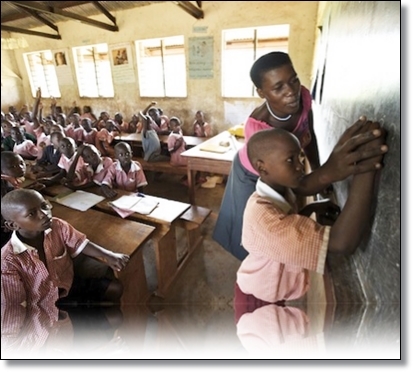UPE: From Quantity to Quality

 |
|
A pupil is helped in a Ugandan classroom P. Courtesy |
I am particularly concerned that most commentators look at achieving super learning outcomes as an event instead of a journey. Achieving 100 percent proficiency for numeracy among fourth graders is a feat that no nation on earth has accomplished. For Uganda, the starting point was expanding access to education by removing children from kraals, gardens, plantations, petty trade, babysitting, housemaid occupations, and lumberjacks’ etcetera to schools and classrooms where they interact with teachers and fellow children.
Since the inception of UPE in 1997, Uganda has seen impressive enrolment rates from 3,068,625 pupils in 1996 to 8,297,000 pupils as of 2009. This in itself is obviously historic. In 2010, Uganda was awarded by the United Nations in 2010 and ranked ahead of schedule in meeting the Millennium Development Goals (MDGs) related to education access and gender parity. Now, the government is focused on consolidating access or enrollment of more children in schools while working to deepen quality.
Whereas most arguments have focused on providing lunch for pupils, increasing teachers’ salaries, building houses for teachers and constructing more classrooms, the Uganda government believes that whereas these are soothing proposals indeed, they are not a silver bullet to fully transform more schooling into increased learning. The government is ensuring that capitation funds are released to schools on time to ensure that children have enough instruction and scholastic materials. Children with books, pencils, instruction materials and teachers are better off than those in furnished classrooms without the foregoing prerequisites.
We have challenges in our schools and we must act quickly to improve learning outcomes. The 2011/2012 Uwezo report for instance recounted that out of the 2, 400 schools visited across the country, 9 out of 10, an equivalent of 92% of the children in P3 could not read a P2 English level story text and that 1 out of 5 of the children in P3 could not even recognize letters of the English Alphabet. The report also revealed that only 17 % of the children in class P7 could not read and understand an English story text of class level P2. Report findings showed that only 31% of the guardians/parents visited the school over the past year to talk to teachers about their children’s learning.
Although 88,373 is not a massive sample, considering we have over 8, million children under UPE, findings nevertheless point to some critical issues that the government is willing to look at, pick lessons from and take action. We for instance know, that primary level 2 and 3 are the critical formative stages for a child’s learning especially acquisition of cognitive and proficiency skills in numeracy and literacy Beyond this level, mastery of numeracy and literacy diminishes –therefore, there is now understanding that focus and effort should be directed at that level/stage.
The revelation that the interest of parents in their children’s learning is at 31 percent is even more appalling. That many parents, over 84% visit their children at school for other reasons but never ask teachers about their children’s learning looks very much unUgandan. Why are parents not getting involved in their children’s learning? Parents, teachers and local councils should coordinate to share common responsibilities and create a convergence of interests for the entire children’s learning process. Such a social compact would increase vigilance, value for money and engender social accountability of all parties involved.
There is a need to liberate ourselves from fixation on process inputs like salaries for teachers, building classrooms, and houses for teachers and build innovative mechanisms that balance inputs and outputs in our education system. The best and viable intervention is placing incentives on delivery of results. For example, tagging incentives on teachers and schools that produce pupils at grade three level with over 80% passing literacy and numeracy tests as a standard pass mark level. In such a system, payments are linked to achieved and verified outcomes. This will inherently mean that against all odds, schools and teachers will focus on getting many children to learn in order to optimize payments from the incentive scheme.
Nancy Birdsall and William Saved off in the book; Cash On Delivery: A new approach to foreign aid, capture and elaborate this approach with distinction. This approach which accentuates results-based incentives has potential for pushing forward the frontiers of education and effective learning in Uganda. Is this something we are willing to debate or rather we want to take the paths of doing the easy things like chalk down strikes ? Over to you.
By Morrison Rwakakamba
Special Presidential Assistant- Research and Information (Head of Unit) mrwakakamba@gmail.com
